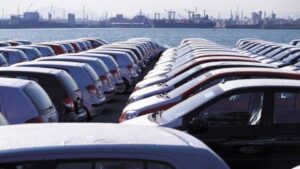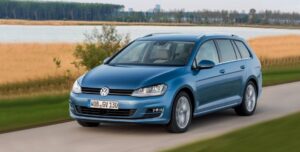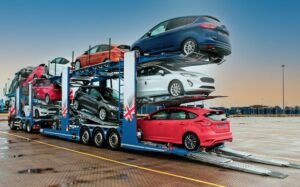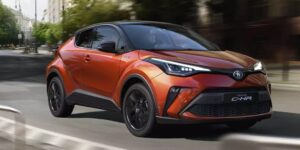
In October this year, Ukrainians purchased 3,114 thousand passenger cars imported from China, which is 2.6 times more than in the same month last year, according to UkrAvtoprom on its Telegram channel.
It is noted that most of the passenger cars purchased from China were new — 2,512 units, which is 2.6 times more than last year. Demand for used cars also increased more than 2.6 times — 602 units were imported.
The vast majority of passenger cars from China were electric vehicles – 92%.
The most popular models of new passenger cars of Chinese origin were Volkswagen ID.UNYX – 441 units; BYD Song Plus – 391 units; BYD Leopard 3 – 261 units; Zeekr 7X – 169 units; BYD Sea Lion 07 – 150 units.
The most frequently purchased used cars were Zeekr 001 – 57 units; BYD Sea Lion 07 – 45 units; Volkswagen ID.UNYX – 36 units; Zeekr 7X – 33 units; and Audi Q4 – 30 units.
As reported, in January-October of this year, China was among the top three countries from which Ukraine imported passenger cars after Germany and the United States, with a share of 13.8% of total imports or $663 million, while in the same period of 2024, it was not among the top three.
In 2024, Ukrainians purchased about 14,400 cars imported from China, which is 18% more than in 2023. Demand for new cars grew by 37% to 11,000 units, while demand for used cars fell by 20% to 3,300 units.
In addition, according to UkrAvtoprom, in October 2025, Ukrainians purchased more than 5,800 used cars imported from the United States, which is 2.2 times more than in the same period of 2024.
The largest share of this number (49%) was electric cars, while gasoline cars accounted for 36%, hybrids – 8%, diesel cars – 4%, and cars with LPG systems – 3%.
The average age of the used American cars that joined the Ukrainian car fleet in October was 5.2 years.
The five most popular used cars manufactured in the US were Tesla Model Y – 900 units; Tesla Model 3 – 841 units; Ford Escape – 408 units; Nissan Rogue – 273 units; Tesla Model S – 270 units.

Ukraine ranked 25th out of 25 in the 2025 European used car market transparency index from carVertical. According to the study, 54.72% of the cars inspected had registered damage, 9.46% had signs of odometer tampering, 78.38% were imported used cars, and the average age was 10.58 years.
The leaders in the ranking are the United Kingdom, Italy, and Germany. In these countries, the risks of mileage manipulation and hidden damage are significantly lower than the European average, according to the authors of the study.
The carVertical index is based on six criteria and covers the period from October 2024 to September 2025.
The methodology and country cards are available on the research project website.

In July this year, almost 20,000 used passenger cars imported from abroad were added to the Ukrainian car fleet, which is 7% more than in the same month last year, according to UkrAvtoprom on its Telegram channel.
As reported, in April and May, this market showed positive dynamics compared to the same month last year, increasing by 14% to more than 22,000 units. That is, compared to May 2025, demand fell by 10% in June.
According to UkrAvtoprom, the average age of used cars registered in Ukraine last month was 8.8 years (in May – 9.3 years).
Gasoline cars traditionally account for the largest share of imported used cars, with a significant lead of 48%. Next, ahead of diesel cars, are electric cars with 23%, diesel cars with 21%, hybrids with 5%, and cars with LPG systems with 3%.
The Volkswagen Golf remains the clear leader in this segment of the car market with 985 registrations in June.
The top ten most popular models also include the Renault Megane (698 units), Skoda Octavia (652 units), VW Tiguan (64 units), Tesla Model Y (567 units), Audi Q5 (560 units), Nissan Rogue (520 units), Tesla Model 3 (513 units), Nissan Leaf (468 units), and VW Passat (451 units)., Nissan Leaf – 468 units, VW Passat – 451 units.
In total, according to the association, Ukrainians purchased 113,400 imported used cars in the first half of the year, which is slightly (0.1%) more than in the same period in 2024.
As reported, according to UkrAvtoprom, in 2024, demand for used foreign cars from abroad increased by 4% compared to 2023, to 222,100 units, which accounted for 75% of the passenger car market.
In turn, the automotive market research institute, analyzing the demand for used cars (imports plus domestic resales), notes on its website that in June 2025, service centers of the Ministry of Internal Affairs registered 71,300 purchase and sale agreements – 12.9% less than in May 2025 and 27.5% less than in June 2024.
Volkswagen also maintained its lead in this segment with a significant margin (8,682 thousand registrations), almost twice as much as its closest competitor BMW (4,129 thousand).
Next in the top ten are Renault, VAZ, and Skoda, which are almost equal to each other (and to BMW) in terms of volume, but are focused on different target groups: The list is rounded out by Audi, Toyota, Ford, Mercedes-Benz, and Hyundai — consistently popular brands that meet the needs of various segments: from budget to premium, from gasoline to hybrids.
Among the models, the most popular in June was the Volkswagen Passat (2,532 thousand units), slightly ahead of the Skoda Octavia (2,124 thousand), with the Volkswagen Golf, which is particularly popular in cities, in third place.
The average age of cars in the secondary resale segment was 15.7 years.
According to the institute, in June, demand for used cars (imports and domestic market) fell by 12% compared to May 2025, to 91,850 units.

The Federation of Automobile Employers of Ukraine (FAU), citing data from Auto-Consulting, has published statistics on sales of new passenger cars.
According to the data, 33.773 thousand passenger cars were sold in Ukraine in January-June.
The first six places in the market remained unchanged compared to May: Toyota is in the lead with sales of 887 cars (4% more than in June 2024, but 20% less than in May 2025), Volkswagen is in second place, with sales more than doubling in June compared to June 2024 – up to 557 units, Renault is third with 547 cars (+32%).
The fourth place is taken by Skoda, which in June increased sales by 69% compared to June last year – 454 units, BYD has already steadily gained a foothold in fifth place thanks to the import of electric cars (453 units), and Huyndai was sixth (284 cars and an increase of 73% compared to June last year).
Zeekr has also increased its influence – now these Chinese electric cars are in seventh place in the Ukrainian market and are ahead of all premium brands in terms of sales.
“It was the import of electric vehicles from China that ensured Honda’s eighth place in June, and contributed to the popularity of many other cars,” according to Auto-Consulting.
The demand for German premium cars remains strong. BMW is the leader here (257 cars – 53% less than in June 2014), followed by Audi with 233 cars (+47%). Both German brands took 9th and 10th place in the Ukrainian market in June.
The FAU also cites Auto-Consulting statistics on sales of light commercial vehicles (LCVs), according to which in June they decreased by 9% compared to June 2024, amounting to 637 units, and for the first half of the year – by 4.6% compared to the same period last year, to 3,856 thousand units.
Thus, in the overall market of passenger cars and light commercial vehicles, the share of LCVs in June amounted to 9.3% (12.2% last year), and for the first half of the year – 10.2% (10.6%).
In this segment, Citroen had the best result in June, with sales up 62% by May 2025, but down 40% by June 2024, to 146 units. Renault was second with sales of 80 vehicles (57% less than in June 2024), and Peugeot took third place with 70 vehicles compared to 27 last year.
At the same time, in the first half of the year, Renault is the leader with a market share of 16.55% and sales of 638 cars (down 58% year-on-year), followed by Citroen – 522 units (-15%) and Ford – 458 units (+87%).

In January 2025, imports of passenger cars, including cargo and passenger vans and racing cars (UKT FEA code 8703), decreased by 17.8% in monetary terms compared to January last year to $333.97 million.
According to customs statistics released by the State Customs Service of Ukraine, the top three countries from which cars were imported were Germany, the United States and Japan.
In particular, imports of cars from Germany increased by 39.6% to $74.64 million, and their share in the structure of car imports amounted to 22.35% against 13.15% a year earlier.
Cars from the United States were imported for $62.51 million (12% less); from Japan, which last year was not among the top three countries with the largest car imports, they were imported for $41.71 million.
At the same time, China was not among the top three in January 2025, with imports from it amounting to $70.7 million in January last year (second place after the United States).
In general, imports of passenger cars from other countries amounted to $155.11 million in January 2025, while a year earlier it was $211.35 million.
At the same time, last month, Ukraine exported such vehicles for $1.09 million, while a year earlier – for $0.76 million, in particular, 90.5% of exports were to the UAE, 3.78% – to Germany, 3.13% – to Moldova, while in January-2024 it was Canada (52.4%), the United States (26.8%) and Germany (7.2%).
As reported, in 2024, Ukraine imported passenger cars worth $4.385 billion, 8% more than a year earlier, and exported $10.1 million (2.7 times less).

Sales of new passenger cars in Ukraine in 2024 are estimated at more than UAH 125 billion, up 18% year-on-year, according to Ukravtoprom’s telegram channel.
According to Ukravtoprom, the initial registrations of new passenger cars in Ukraine last year increased by 14% to 69.6 thousand units, and according to Auto-Consulting, their sales increased by 9.8% to 71.3 thousand units.
“Ukravtoprom informs that about half of the amount spent on the purchase of new cars was spent on five car brands, with the leader being Japanese Toyota – UAH 18.3 billion.
BMW came in second with UAH 16 billion, Mercedes-Benz took third place with UAH 9.7 billion, Volkswagen was fourth with UAH 9.2 billion, and Renault rounded out the top five with UAH 6.4 billion.
Audi, Skoda, Lexus, Land Rover, and Porsche are also among the top ten brands of new cars that Ukrainians have spared no expense.
As reported, according to Ukravtoprom, the top five registrations in quantitative terms were Toyota (10.73 thousand), Renault (7.27 thousand), Skoda (5.03 thousand), Volkswagen (4.9 thousand), and BMW (4.83 thousand). At the same time, Mercedes-Benz did not make it into the top ten, and in December 2024 it ranked 12th in terms of the number of cars sold.